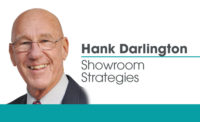Your New Year's plan

I have always loved the beginning of a newyear — both from a personal and business point of view. I’m one of those folks that not only makes a New Year’s resolution or two, but I try very hard to follow through on them. One of my favorites was committing to send short notes of thanks, recognition and/or acknowledgement to someone every day of the year. Some went to friends and relatives — some went to total strangers. It was a bit of work, but it was a good feeling! If you’re wondering how I did, I probably sent out about 300 notes out of the 365 days. Not perfect, but not bad either. It became a habit and I still continue to do it.
On the business side, I always looked forward to putting together a business plan for the New Year. This would include a detailed financial budget, marketing plan, a showroom update schedule, any human-resource considerations and any major changes in the direction of the business. This would serve as my roadmap for running the business for the next 12 months. It was never set in concrete — it had lots of flexibility. We could add, delete or change it anytime we saw fit.
As I travel the country doing consulting and giving talks I am usually very disappointed by the lack of planning and forecasting I find in many businesses. Many wholesalers do some or all of the above for their total business, but very few do a breakout on the showroom portion of their business. The showroom business is different enough that I believe it should have its own detailed road map for the New Year. How in the world will you meet your goals if you haven’t set any?
When I travel now I can’t survive without my GPS to give me directions. Good business planning and budgeting are just as important to your business. You’ll have trouble getting where you want to go if you don’t implement your showroom GPS.
Most businesses work on a calendar year fiscal business cycle (Jan. 1 to Dec. 31). Thus December is the perfect time to put together your new plans and budgets. It really is pretty easy. Use the historic data from the past two or three years. Get input on the economic projections from your vendors, business bankers, financial advisors, etc. Get out your own crystal ball and go to work forecasting what you believe will take place in the next 12-month period. Your plan and budget should remain flexible. You can change them as the year progresses.
The big advantage of doing this exercise is it eliminates surprises. It tells you when you may need to add another sales consultant or tighten your belt on expenses. It lets you know when there will be money available to do a little extra marketing or to update a section of the showroom. Most importantly, it sets sales, margin, expenses and profitability goals that will help you maximize your showroom return on investment.
If you are a manager, you can make this happen. If you’re a salesperson, you can put this article in front of your supervisor and tell them you’d be happy to help with this important project. Now is the time of year it should happen. Here are some New Year’s tips.
Detailed 12-month budget:This includes sales, cost of goods sold, gross profit dollars and percentage, expenses (broken out in as much detail as possible) and a showroom net profit number. The budget layout should replicate your monthly showroom profit-and-loss statement. Each month of the upcoming year you plug in actual numbers and compare how you’re doing. I like doing a 12-month Excel spreadsheet so you can make line-by-line comparisons on your progress. It’s also helpful to have the previous year’s spreadsheet so you can track any unusual spikes.
Sales and gross margin goals and results:I love keeping score. Again, use historic sales and margin numbers to set the year’s goals. Sit with each sales consultant and come up with the goals. Then each month do a monthly report card on the results. Everyone deserves to know what’s expected of them and how they’re doing. I also believe in tying incentives to these goals (i.e. the more you sell and the higher the margin, the more you can make).
Incentives:To expand a little more, I like incentives and so do most sales folks. We used a sliding scale commission program for sales consultants at our business. These people received about 2/3 of their compensation in salary or hourly pay and the rest was driven by sales and margin on sales. In addition to this we had a team incentive for each of our three showrooms. This was a monthly goal on sales and GP percentage. If the store hit its goal everyone at the store received extra dollars. This was easy to put in place and it was good for both the employees and the company.
Marketing plan and budget:First, you must decide how much money will be budgeted for all marketing activities. We used 5% of sales at our business of which we received about 1.5% back from our vendor partners via co-op dollars. Once you have a dollar amount decide where you want to spend it. List all potential activities. Prioritize them and put the whole plan/budget on a 12-month spreadsheet. Show exactly what, when and how much for each month of the year. As the year progresses you have flexibility to add, change or delete as economics dictate.
Training plan and schedule:At our business we held weekly staff meetings. They were held from 8-9 a.m. every Friday. About half were devoted to product knowledge and half to sales and computer training, and general communication and motivation. We had a written training schedule broken out by day, week and month, and ongoing for all employees. We had vendor partners lining up to get on the product-knowledge meeting schedule.
Display and product updates:You should be changing out at least 25% of your showroom products and displays annually. I know several folks who try to change at least one-third of everything each year. This keeps your showroom fresh exciting and up to date. It’s good for your customers, your sales staff (they get bored talking and showing the same things day in and day out) and it’s good for your vendor partners. In most cases it’s only the product getting changed out, but how that product is shown needs to be changed on a regular basis as well. Many times a new coat of paint will achieve the look you need. In other cases, the boxes, boards and vignettes may need to be cycled out.
New technology plan:This means getting rid of those awkward three-ring binders and going to tablets, laptops, smartphones and flat-screen monitors. The use of QR codes and an instore app is very customer and sales-consultant friendly. Also, you’re website and social media sites (Facebook, Houzz and Pinterest being the most popular) should be the best in your marketplace.
The right number of employees:You must always be able to provide outstanding customer service, but the challenge is keeping expenses in line with revenues. An annual business plan and budget are the tools you use to make these decisions. Walking the tight rope, rendering exceptional customer service and maintaining employee morale and attitude is an ongoing challenge for management. Here’s a Darlington guideline for sales consultant productivity. I believe one salesperson can and should average $75,000 or more per month. Unfortunately, I believe the average is well below that.
Cash-flow projections:Do all the above correctly on a monthly basis and you’ll be able to determine what your cash-flow requirements will be. You goal is to eliminate all surprises.
Analyze and evaluate vendor partners:This is something many companies don’t do on a regular basis. Are you showing too many faucet or tub lines? Are you really an important partner to all your suppliers? How do your vendors protect you on Internet pricing? Is the local rep adding value to the relationship? If there are areas that need to be strengthened now is the time to identify them and try to seek improvement. You are the customer and you deserve the best service in all areas. By doing an in-depth evaluation of your main vendors and communicating your concerns to them you will strengthen those important relationships.
This may seem like a daunting task. The first time you do this it will take a bit of time, smarts and energy. But once you’ve done it, it gets easier and easier. Please carve out a bit of time at the end of the year and put a plan together for the new one. You’ll be happy you did.
Happy selling!
Looking for a reprint of this article?
From high-res PDFs to custom plaques, order your copy today!






